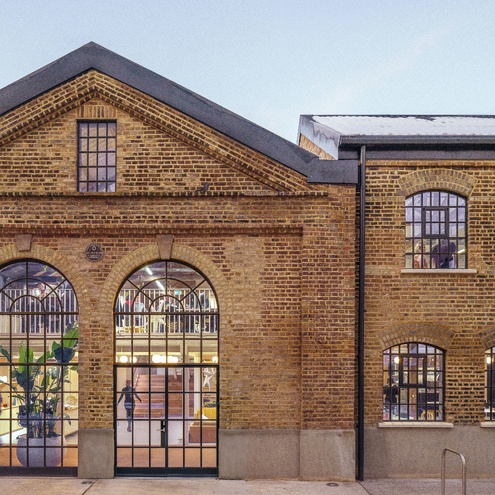Project showcase
75 Wallis Road, Hackney Wick, Hackney – HTA Design LLP

After completing an initial refurbishment phase, HTA Design LLP has taken over a 19th Century heritage building as their new studio space in Hackney Wick. The project provides creative workspace for 200 people and has a focus on lightness throughout, to connect each space in the two-storey building across its 60m length.
Who is on the project team?
Client team: Simon Bayliss and Colin Ainger - HTA Design
Architect: Samuel Pew Latter (Project Architect) Rachel Hardman, Sandy Morrison – HTA Design
Sustainability consultant: Rory Bergin, Stavroula Koutroumpi - HTA Design
Describe the context of this project?
Our project is right in the heart of Hackney Wick, East London’s most fascinating and culturally diverse neighbourhoods. The brief was to create a permanent home for our practice, HTA Design, and secure the future of a venerable 19th century warehouse.
Hackney Wick has a history of innovation and making, a place where products and processes from confectionary to petrol, rubber and lace, were invented and manufactured over the course of 150 years. The factories and belching chimneys are long gone and, boosted by the 2012 Olympics, the a new neighbourhood has emerged over the past decade, primarily as a place to live. This new place is, by and large, carefully designed and well-constructed, under the watchful stewardship of the LLDC. A variety of mid-rise, brick-clad, apartment blocks are home to a new generation drawn to the area by the ever-expanding cultural facilities of Stratford and the Olympic Park. Perhaps of even greater influence in the post-pandemic city, the green open spaces of the Victoria and Queen Elizabeth parks, and the twisting network of canals and rivers connect to the wilderness of Hackney Marshes nearby
The business case was simple: create a beautiful and practical studio space, protect the practice from the uncertainty of renting, and reduce our carbon footprint.
Tell us what you did and how the project enlivened the place?
The project retains the basic structure and celebrates the huge variety of colour and texture inherent in the various bricks and mortars used through the ages. Huge timber trusses with 10m spans aided by ironwork strapping and tension rods look good for another 150 years. The existing structure provides protection as the building envelope, but it also offers a new public face for our business, displaying our creative purpose.
The innovation comes from the lightness with which we have connected the spaces, over 2 storeys in a building 60m long, ensuring every part of the studio is easily accessible. Similarly, the plan is configured to create varied spaces and characters to best meet the need of the modern workplace with added drama of double height spaces. Services and acoustics, sustainable materials including reclaimed timber and cork, meet our ambitions for a more circular economy.
We learned of the building’s history as the home of the world’s first synthetic plastic. An environmental breakthrough in its day as a viable alternative to ivory for piano keys and billiard balls, the chemical process led to celluloid and the birth of photography and film. Subsequently used to manufacture lace and rubber, it was most recently a book depository for Central Books, a communist publishing company.
Did the project make a positive social and environmental contribution?
The project uses a combination of air-source-heat-pumps and rooftop photovoltaic panels to maximise renewable energy within an all-electric building, targeting 20% by renewables. A passive design strategy relies on natural light, ventilation through opening windows and rooflights, well-insulated roofs and floors, and the significant thermal mass of exposed brickwork walls. Design stage modelling indicates that heating and cooling will only be required on extreme days and, despite some extremely cold days in December, only minimal heating has been required so far. Environmental modelling suggests we will generate up to 20% of our energy needs, and monitoring is underway to determine most efficient modes of operation.
The positive social impact of the project will grow as we settle into the neighbourhood and learn how best to live with our neighbours. The location has enabled us to make good on our ambition to ‘bring nature home’, with HTA’s cycling, running and tennis clubs already making the most of the area. Showers are plentiful, towels and natural soaps provided, with a drying cupboard for wet gear, with many more cycling to work. As before, lunch and breakfast, from locally sourced suppliers, is served everyday.
Festival of Pineapples
24-26 February 2026
Pineapples prize giving night
April
Pineapples at Festival of Place
10 June 2026
© The Pineapples - Tweak Ltd. 124 City Road, London, EC1V 2NX. Tel: 020 3326 7238




